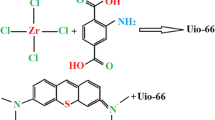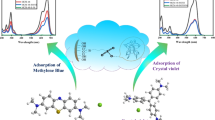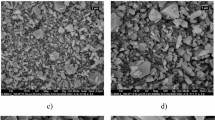Abstract
Adsorption is known as the best technique to remove dyes from waste water, and the choice of adsorbent is the most important factor. In this regard, some commercial porous materials have been applied for a long time as popular adsorbents for dye adsorption. However, the search for new classes of porous materials is still attractive to researchers. Recently, metal-organic frameworks are seen to be promising candidates as adsorbents for dyes due to their large surface area, ordering, and flexible structure. There are some possible mechanisms for the dye adsorption in water performed on metal-organic frameworks, including the electrostatic interaction forming attractive charge of dye molecules and adsorbents, π–π stacking of organic rings from dye and metal-organic frameworks, hydrogen bonding between the dye and hydroxyl group of the metal-organic frameworks, hydrophobic interaction, acid-base interaction and effect of framework structure. Among them, the electrostatic attraction mechanism plays an important role in dye adsorption on MOFs, highlighting differences as compared to traditional adsorbents in this field. This work is the first detailed investigation into the effect of electrostatic attraction mechanism in dye adsorption on UiO-66 and their modifications. Two samples of Co/UiO-66 and H+/UiO-66 were prepared under normal stirring and heating conditions to increase the positive charge of the surface. The characterization using powder X-ray diffraction (XRD), scanning electron microscopy (SEM) and FTIR indicated the existence of proton on UiO-66, while Raman spectroscopy and inductively coupled plasma mass spectrometry (ICP-MS) confirmed the successful addition of cobalt into the UiO-66 structure at the amount of about 0.6 wt %. Results obtained for methyl orange (MO) adsorption on the surface have shown enhanced adsorption capacity for both Co-UiO-66 and H+/UiO-66 as compared to parent UiO-66. Moreover, the experiments with highly selective removal of anionic dye as compared to cationic dye were performed and explained in detail for mixed dye solutions of MO with methylene blue (MB), indicating the important role of electrostatic attraction mechanism. Notably, it is shown that the addition of Co to UiO-66 results in a higher effect of electrostatic interaction than that of H+.




Similar content being viewed by others
REFERENCES
Cavka, J.H., Jakobsen S., Olsbye U., Guillou N., Lamberti C., Bordiga S., and Lillerud, K.P., A new zirconium inorganic building brick forming metal organic frameworks with exceptional stability, J. Am. Chem. Soc., 2008, vol. 130, no. 42, pp. 13850–13851.
Aceituno Melgar, V.M., Kim, J., and Othman, M.R., Zeolitic imidazolate framework membranes for gas separation: A review of synthesis methods and gas separation performance, J. Ind. Eng. Chem., 2015, vol. 28, pp. 1–15.
Zhang, K., Lively, R.P., Dose, M.E., Brown, A.J., Zhang, C., Chung, J., Nair, S., Koros, W.J., and Chance, R.R., Alcohol and water adsorption in zeolitic imidazolate frameworks, Chem. Commun. (Cambridge), 2013, vol. 49, no. 31, pp. 7–3245.
Schaate, A., Roy, P., Godt, A., Lippke, J., Waltz, F., Wiebcke, M., and Behrens, P., Modulated synthesis of Zr-based metal-organic frameworks: From nano to single crystals, Chem.–Eur. J., 2011, vol. 17, no. 24, pp. 6643–6651.
Wang, K., Li, C., Liang, Y., Han, T., Huang, H., Yang, Q., Liu, D., and Zhong, C., Rational construction of defects in a metal-organic framework for highly efficient adsorption and separation of dyes, Chem. Eng. J., 2016, vol. 289, pp. 486–493.
Yang, J.-M., A facile approach to fabricate an immobilized-phosphate zirconium-based metal-organic framework composite (UiO-66-P) and its activity in the adsorption and separation of organic dyes, J. Colloid Interface Sci., 2017, vol. 505, pp. 178–185.
Chen, Q., He, Q., Lv, M., Xu, Y., Yang, H., Liu, X., and Wei, F., Selective adsorption of cationic dyes by UiO-66-NH2, Appl. Surf. Sci., 2015, vol. 327, pp. 77–85.
Qiu, J., Feng, Y., Zhang, X., Jia, M., and Yao, J., Acid-promoted synthesis of UiO-66 for highly selective adsorption of anionic dyes: Adsorption performance and mechanisms, J. Colloid Interface Sci., 2017, vol. 499, pp. 151–158.
Han, Y., Liu, M., Li, K., Sun, Q., Zhang, W., Song, C., Zhang, G., Conrad Zhang, Z., and Guo, X., In situ synthesis of titanium doped hybrid metal-organic framework UiO-66 with enhanced adsorption capacity for organic dyes, Inorg. Chem. Front., 2017, vol. 4, no. 11, pp. 1870–1880.
Yang, J.-M., Ying, R.-J., Han, C.-X., Hu, Q.-T., Xu, H.-M., Li, J.-H., Wang, Q., and Zhang, W., Adsorptive removal of organic dyes from aqueous solution by a Zr-based metal–organic framework: Effects of Ce(III) doping, Dalton Trans., 2018, vol. 47, no. 11, pp. 3913–3920.
Li, T.-T., Liu, Y.-M., Wang, T., Wu, Y.-L., He, Y.-L., Yang, R., and Zheng, S.-R., Regulation of the surface area and surface charge property of MOFs by multivariate strategy: Synthesis, characterization, selective dye adsorption and separation, Microporous Mesoporous Mater., 2018, vol. 272, pp. 101–108.
Katz, M.J., Brown, Z.J., Colón, Y.J., Siu, P.W., Scheidt, K.A., Snurr, R.Q., Hupp, J.T., and Farha, O.K., A facile synthesis of UiO-66, UiO-67 and their derivatives, Chem. Commun., 2017, vol. 49, no. 82, p. 9449.
Yang, J., Zheng, C., Xiong, P., Li, Y., and Wei, M., Zn-doped Ni-MOF material with a high supercapacitive performance, J. Mater. Chem., A., 2014, vol. 2, no. 44, pp. 19005–19010.
Botas, J.A., Calleja, G., Sánchez-Sánchez, M., and Orcajo, M.G., Cobalt doping of the MOF-5 framework and its effect on gas-adsorption properties, Langmuir, 2010, vol. 26, no. 8, pp. 5300–5303.
Ebrahim, A.M. and Bandosz, T.J., Ce(III) doped Zr-based MOFs as excellent NO2 adsorbents at ambient conditions, ACS Appl. Mater. Interfaces, 2013, vol. 5, no. 21, pp. 10565–10573.
Cheng, J.P., Chen, X., Wu, J.-S., Liu, F., Zhang, X.B., and Dravid, V.P., Porous cobalt oxides with tunable hierarchical morphologies for supercapacitor electrodes, CrystEngComm., 2012, vol. 14, no. 20, p. 6702.
Mohammadi, A.A., Alinejad, A., Kamarehie, B., Javan, S., Ghaderpoury, A., Ahmadpour, M., and Ghaderpoori, M., Metal-organic framework Uio-66 for adsorption of methylene blue dye from aqueous solutions, Int. J. Environ. Sci. Technol., 2017, vol. 14, no. 9, 1959–1968. .
Atzori, C., Shearer, G.C., Maschio, L., Civalleri, B., Bonino, F., Lamberti, C., Svelle, S., Lillerud, K.P., and Bordiga, S., Effect of benzoic acid as a modulator in the structure of UiO-66: An experimental and computational study, J. Phys. Chem C., 2017, vol. 121, no. 17, pp. 9312–9324.
Kandiah, M., Nilsen, M.H., Usseglio, S., Jakobsen, S., Olsbye, U., Tilset, M., Larabi, C., Quadrelli, E.A., Bonino, F., and Lillerud, K.P., Synthesis and stability of tagged UiO-66 Zr-MOFs, Chem. Mater., 2010, vol. 22, no. 24, pp. 6632–6640.
Maschio, L., Kirtman, B., Rérat, M., Orlando, R., and Dovesi, R., Ab initio analytical Raman intensities for periodic systems through a coupled perturbed Hartree–Fock/Kohn–Sham method in an atomic orbital basis. II. Validation and comparison with experiments, J. Chem. Phys., 2013, vol. 139, no. 16, art. ID 164102.
Nickolov, Z., Georgiev, G., Stoilova, D., and Ivanov, I., Raman and IR study of cobalt acetate dehydrate, J. Mol. Struct., 1995, vol. 354, no. 2, pp. 119–125.
Rivas-Murias, B. and Salgueiriño, V., Thermodynamic CoO–Co3O4 crossover using Raman spectroscopy in magnetic octahedron-shaped nanocrystals, J. Raman Spectrosc., 2017, vol. 48, no. 6, pp. 837–841.
Hu, Y.H. and Zhang, L., Amorphization of metal-organic framework MOF-5 at unusually low applied pressure, Phys. Rev. B., 2010, vol. 81, no. 17, p. 174103.
Ewen, S. and Geoffrey, D., Modern Raman Spectroscopy: A Practical Approach, 2nd ed., Chichester: Wiley, 2019, pp. 1–20.
Jiang, C., Fu, B., Cai, H., and Cai, T., Efficient adsorptive removal of Congo red from aqueous solution by synthesized zeolitic imidazolate framework-8, Chem. Speciation Bioavailability, 2016, vol. 28, nos. 1–4, pp. 199–208.
Zhang, Z.-H., Zhang, J.-L., Liu, J.-M., Xiong, Z.-H., and Chen, X., Selective and competitive adsorption of azo dyes on the metal–organic framework ZIF-67, Water, Air Soil Pollut., 2016, vol. 227, no. 12.
Liu, X., Gong, W., Luo, J., Zou, C., Yang, Y., and Yang, S., Selective adsorption of cationic dyes from aqueous solution by polyoxometalate-based metal-organic framework composite, Appl. Surf. Sci., 2016, vol. 362, pp. 517–524.
Hasan, Z. and Jhung, S.H., Removal of hazardous organics from water using metal-organic frameworks (MOFs): Plausible mechanisms for selective adsorptions, J. Hazard. Mater., 2015, vol. 283, pp. 329–339.
Ayati, A., Shahrak, M.N., Tanhaei, B., and Sillanpää, M., Emerging adsorptive removal of azo dye by metal-organic frameworks, Chemosphere, 2016, vol. 160, pp. 30–44.
García, E.R., Medina, R.L., Lozano, M.M., Hernández Pérez, I., Valero, M.J., and Franco, A.M.M., Adsorption of azo-dye orange II from aqueous solutions using a metal-organic framework material: iron-benzenetricarboxylate, Materials (Basel), 2014, vol. 7, no. 12, pp. 8037–8057.
Author information
Authors and Affiliations
Corresponding author
About this article
Cite this article
Tran Ba Luan Dye Adsorption on UiO-66: the Importance of Electrostatic Attraction Mechanism. J. Water Chem. Technol. 42, 441–449 (2020). https://doi.org/10.3103/S1063455X20060107
Received:
Revised:
Accepted:
Published:
Issue Date:
DOI: https://doi.org/10.3103/S1063455X20060107




